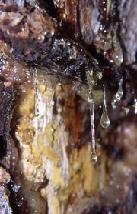
Almaciga (Agathis philippinensis Warb.) is utilized in the production of resin known in the world trade as almaciga resin or Manila copal. Almaciga resin is used in the manufacture of varnishes, lacquer, soap, paint, printing inks, linoleum, shoe polish, floor wax, plastic, water proofing materials, paper sizing and many other products. Locally, it is used as incense in religious ceremonies, as fuel, torches, caulking substances and smudge for mosquitoes. Although regarded as a minor forest product, it is one of the country's leading dollar earners. In 1997, the Philippine Forestry Statistics reported that 381,000 kg of almaciga resin valued at US$303,000 were exported.
Almaciga tree grows in almost all mountainous forests, but most particularly in Quezon, Zambales, Palawan, Cagayan, Abra, Kalinga Apayao, Nueva Vizcaya, Samar, Zamboanga and Davao. High export quality products are those that come from Palawan and Quezon.
There are two kinds of almaciga resin: the ground or fossil resin, and the surface or tapped resin. Fossil resin is the amber-coloured exudation from the roots. It is obtained by digging into the ground where the almaciga once grew. In contrast, surface resin is extracted by tapping a living almaciga tree. It is soft when fresh, but hardens over time as it flows freely and later turns to amber-coloured like the fossil resin. Between the methods, tapping is the easier way to produce Manila copal.
Procedures:
1. Almaciga tree with 35.5 cm. diameter can be tapped for resin.
2. The total length of the cut is about 1/3 of the total tree circumference. Each cut is 30 cm long and 1-12 cm wide with a 30 cm space between each cut.
3. More cuts could be made out of a big trees compared to small ones. A tree with 115-155 cm diameter maybe be cut 5-6 times while only one for smaller trees.
4. The quality of resin taken during summer is higher than those taken during season.
5. Resin has a higher quality if it is clean. Cut hardened resin into small pieces, soak in water for a week, then air dry. Grind firmly and place in 95% ethyl alcohol to melt. First class quality resin melts in 97% ethyl alcohol.
6. Almaciga trees grown in lowland produce more resin than those grown in the highlands. The bark from the lower part of the tree is soft and thick and produce more resin.
Source: elgu2.ncc.gov.ph, IMPROVED TAPPING OF ALMACIGA TREE FOR SUSTAINED RESIN YIELD, Mr. Arsenio B. Ella, Forest Products Research & Development Institute (FPRDI), LAGUNA, Philippines; photo courtesy of wikipedia.

No comments:
New comments are not allowed.